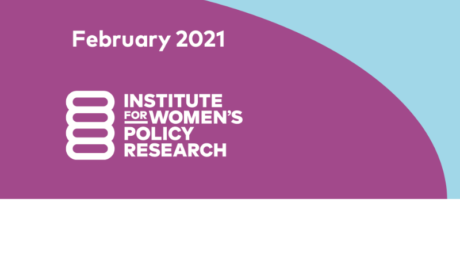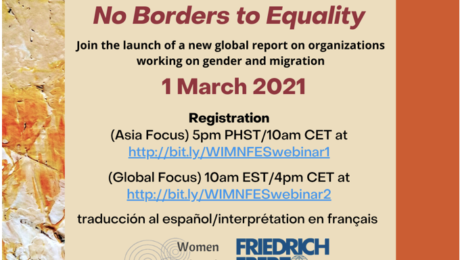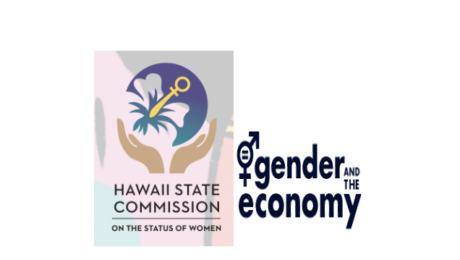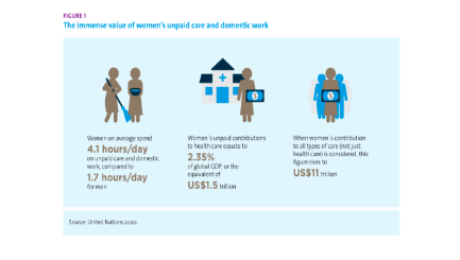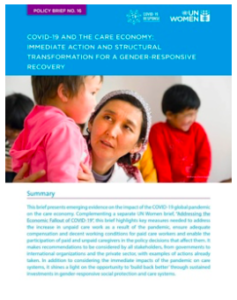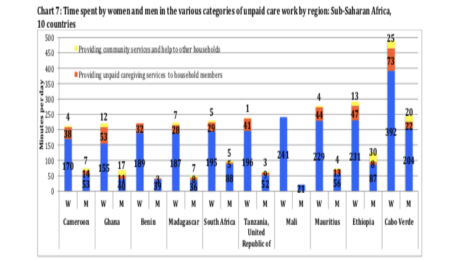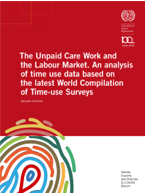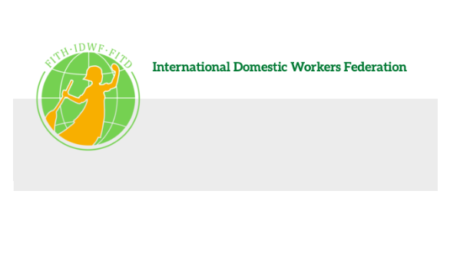Women and the Pandemic in the U.S.
Institute for Women’s Policy Research released a report in February 2021”IWPR Women’s Priorities and Economic Impact Survey” outlining a recent poll of 1452 women in the U.S. The findings are backdropped by the experience of women throughout the pandemic and resulting economic turndown, in which 2.35 million women have left the workforce since February 2020.
Some of the key findings from this survey are:
- 1 in 4 women report that they are worse off financially than one year ago
- Nearly half of all women are worried about the financial situation of their families
- 1 in 4 women report having needed to take time work off but did not do so
- 40% of women reported care demands stopped them from working or forced them to reduce hours
- 69% of women support paid sick time to have a child, recover from a serious health condition, or care for a family member
- 20% of women with children want the Biden administration to address childcare and education in the first 100 days
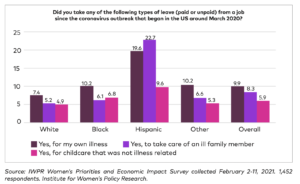
In terms of women experiencing reduced paid work as a result care demands, this has also been pointed to within recent working papers put out by the
The impact of care demands on women’s paid work is explored in a number of Care Work and the Economy Working Paper Series. For instance in two recent papers, “Gender Wage Equality and Investments in Care: Modeling Equity and Production” and “Parental Caregiving and Household Dynamics”.
Education and childcare were listed among the top priorities for the Biden administration to address within the first 100 days among survey participants. This is largely because women’s ability to reenter the workforce largely depends upon safe reopening of schools and childcare facilities.
Latinas have been hit particularly hard according to this survey, reporting the highest levels of taking leave from jobs in order to provide care. However, across all ethnicities, 69 percent of women expressed strong support for paid sick leave and the ability to take time away from work to provide care or recover from illness.
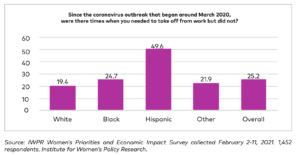
The Unites States remains the only high-income country in in the world that fails to provide guaranteed paid sick or family leave for workers. The Family Medical Leave Act, which provides unpaid job protection, and only for about 56 percent of workers. The Families First Coronavirus Relief Act has provided access to paid leave as a result of the pandemic but falls short in the fact that more than 100 million workers are excluded from this because they are caregivers.
In order to address the many issues identified throughout this survey, there is strong need for targeted programs and policy solutions that will aid a gender equitable recovery. This recovery should not only address immediate short term needs but include long term strategies that will create more resilient systems that recognize the contributions of women to the workforce, society and family structure.
IWRP specific recommendations for the short term are:
- Continuing economic impact payments
- Expanding access to affordable healthcare
- Providing paid sick and medical leave
- Raising the federal minimum wage
- Building a new childcare infrastructure
Equitable economic recovery necessitates a national care system that meets the needs of all families, raises wages and provides quality childcare, treating it as a public good instead of a private obligation.
This blog was authored by Jenn Brown, CWE-GAM Communications Assistant
- Published in Child Care, Gender Inequalities, Policy, Policy Briefs & Reports, U.S.
Save the Date: Women & Migration Global Mapping Report
On March 1st the Women in Migration Network and Friedrich-Ebert- Stiftung is launching a new report mapping organizations working on gender and migration around the world “No Borders to Equality.”
This new report has mapped over 300 organizations around the world working at the intersection of gender and migration. It is based on a survey and interviews that identify key priorities, concerns, advocacy and mobilization, and which reveal the tremendous potential and importance of bringing a gender perspective to the dynamic issues of migration today.
In addition to the report (which will be available in English and with an Executive Summary in English, Spanish and French), an interactive website is being developed to help in identifying and locating these key groups in the various global regions.

To accommodate global time zones, the launch event will take place at two different times. You can register for either event:
(Asia Focus) 5pm PHST/10am CET
Register at: http://bit.ly/WIMNFESwebinar1
(Global Focus) 10am EST/4pm CET
Register at: http://bit.ly/WIMNFESwebinar2
– traducción al español
– interprétation en français
Be sure to attend this exciting event to learn more.
- Published in Events, Gender Inequalities, Policy Briefs & Reports
Hawai’i and Canada Provide Lessons for Feminist Economic Recovery from COVID-19
The need for an inclusive, gender-equitable recovery from the COVID-19 pandemic is slowly gaining recognition as it lays bare and exacerbates inequities in economic, social, health, and environmental policies and programs.
The Hawai’i State Commission on the Status of Women convened a working group to develop and share principles and practices for implementing a gender-responsive and feminist response to COVID-19, culminating in the publication of Building Bridges, Not Walking on Backs: A Feminist Economic Recovery Plan for COVID-19.
Similarly, the YWCA Canada and the Institute for Gender and the Economy (GATE) at the University of Toronto’s Rotman School of Management published a joint assessment, A Feminist Economic Recovery Plan for Canada: Making the Economy Work for Everyone. The plan highlights critical principles and provides actionable recommendations for the government to develop and implement post-pandemic recovery policies that are equitable and inclusive of all marginalized people.
Together, the Canadian and Hawaiian plans provide a roadmap to recovery through gender-transformative policy-making. Both are built on an intersectional analysis of the impact of the pandemic and call for an approach to economic recovery that examines and confronts the root causes of inequality, including but not limited to patriarchy, ableism, queerphobia, white supremacy, colonialism, classicism, and racism.
A recent brief by Alexandra Solomon, Kate Hawkins, Rosemary Morgan of the Gender and COVID-19 Working Group describes the intersecting, complementary, and mutually reinforcing elements of the two frameworks and echoes the call for feminist economic recovery. It provides a collection of best practices for the core tenets of post-pandemic policy-making which should be echoed and adapted by policy-makers from other settings.
Key Recommendations to Policymakers:
- Pandemic responses should be underpinned by data that is disaggregated by sex and other markets of inequity at the national and subnational level. This data should be made public and used in decision making.
- Women-led organizations, feminist academics and women’s experiences and ideas should be at the center of recovery efforts in government bodies, official consultations and online spaces.
- The provision of universally accessible, free childcare and long-term eldercare should be central to economic recovery plans and attempts to ‘open up’ the economy. Precariously employed immigrant care workers should be provided with an expedited path to permanent resident status.
- Austerity-induced budget cuts should be avoided as they impact most greatly on the poor, women and other marginalized groups. Instead policy-makers should strengthen public welfare assistance (such as unemployment benefit) and labor rights (such as paid sick leave, family leave and a guaranteed living wage).
- Special stimulus funds should be designated for high risk groups, such as those who are not eligible under existing government schemes, are disproportionately experiencing financial hardship and poverty, and already face barriers to accessing their rights to health, safety, independence and education.
- Invest in universal, affordable, and sustainable access to water, sanitation, hygiene and housing, and prioritize closing the gender digital divide.
- Support women in female dominated economic sectors particularly hard hit by the pandemic as well as historically marginalized women workers, such as Indigenous women and sex workers.
- A feminist recovery is aligned with a ‘green’ recovery and the two should be considered in conjunction.
- Revisions of fiscal and monetary policies should be taken as opportunities to address inequality in wages, employment, and quality of life.
- Health systems should be restructured to focus on Universal Health Coverage and to address problems in service access and quality due to sexism, colonialism and white supremacy. Tackling the social determinants of health should be a priority.
- All hate, violence, and oppression against women, gender-diverse people, and Indigenous, Black, and racialized communities must be addressed in the COVID-19 recovery.
READ FULL BREIF:
Solomon, A., Hawkins, K., and Morgan, R. (2020). Hawaii and Canada: Providing lessons for feminist pandemic recovery plans to COVID-19.The Gender and COVID-19 Working Group.
This blog was authored by Shirin Arslan, Program Manager for the Care Work and the Economy Project
- Published in COVID 19, Policy, Policy Briefs & Reports
COVID-19 AND THE CARE ECONOMY: UN Women calls for immediate action and structural transformation for a gender-responsive recovery
A recent brief from UN Women presents emerging evidence on the impact of the COVID-19 global pandemic on the care economy.
Evidence suggests that the rising demand for care in the context of the COVID-19 crisis and response will likely deepen already existing inequalities in the gender division of labor, placing a disproportionate burden on women and girls. Not only are women over-represented among paid health care workers, girls and women also shoulders the bulk of unpaid care and domestic work that sustains families and communities on a day-to-day basis.
School closures and household isolation across the globe are moving the work of caring for children from the paid economy—schools, day-care centers, and babysitters—to the unpaid economy. So far, 1.27 billion students (72.4 percent) across 177 countries have been affected by school closures (UNESCO). The lack of childcare support is particularly problematic for essential workers, including those in the health sector, who have care responsibilities.
This brief recommends ways to transform care systems now and for the future – both the need for immediate support and the need for sustained investment in the care economy for long term recovery and resilience.
How to Transform Care Systems – Now and for the future
(UN Women, 2020)
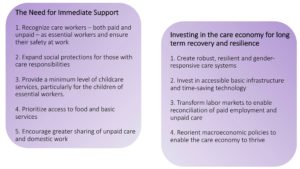
Authors/editor(s): Bobo Diallo, Seemin Qayum, and Silke Staab 2020
- Published in COVID 19, Policy Briefs & Reports, UN Women
The Unpaid Care Work and the Labor Market. An analysis of time use data based on the latest World Compilation of Time-use Surveys
How much time do people spend on doing paid and unpaid care work? How do women and men spend their time differently on unpaid care work? Are there any differences in time use among the regions? How do socioeconomic factors influence people’s choices to do paid and unpaid care work?
Jacques Charmes addresses these questions in recent ILO report by providing a comprehensive overview of the extent, characteristics and historical trends of unpaid care work. The report is based on the analysis of the most recent time-use surveys carried out at the national level across the world, revealing the differences in time spent on unpaid care work between women and men and among people with different socioeconomic characteristics, such as geographical location, age and income groups, education level, marital status and the presence and age of children in the household. An insightful discussion of the concepts and methodological approaches underlying the analysis of time-use data is also offered.
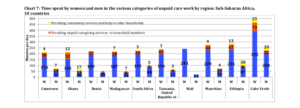
Chart 7 in the ILO Working Paper the Unpaid Care Work and the Labour Market. An analysis of time use data based on the latest World Compilation of Time-use Surveys illustrates the time spent by women and men in various categories of unpaid care work across Sub-Saharan African countries including Cameron, Ghana, Benin, Madagascar, South Africa, Tanzania, Mali, Mauritius, Ethiopia and Cabo Verde. As with the case around the world, women in Sub-Saharan African countries are providing significantly more unpaid care services in households and communities. Read the report to learn more about time-use analysis concepts and methodologies, gender variations in paid and unpaid work across the world and across various socio-economic levels:
International Labour Organization
Gender, Equality and Diversity & ILOAIDS Branch
This blog was authored by Shirin Arslan, Program Manager for the Care Work and the Economy Project
- Published in Child Care, elderly care, Policy Briefs & Reports
Responsibility Time
If there was ever a time we urgently needed to know more about time use, that time has come. The Covid-19 pandemic utterly changed daily rhythms for many sequestered households and the “opening up” process closed down some old routines.
I’ve done extensive work with time use data, have been in touch with several people/groups trying to measure the impact of the pandemic, and am trying to follow results being reported in other research.
My reactions are conditioned by long-standing concerns about survey methodology.
It is surprisingly hard to get an accurate picture of how people use time, because we all tend to do more than one thing at once. Also, doing is not the whole story—being present, available, on-call, and taking responsibility for others is typically far more time-consuming than specific acts of helping. This is especially true for the care of young children, people who are sick, frail, or suffering a disability.
Sheltering-in-place guidelines, combined with the social distancing, have probably had a much bigger impact on where people are, who they are with, and what they are responsible for—than on their activities.
Yet most surveys focus on activities alone, in several variations. They ask stylized questions about how much time people spent in various activities in a given time period, such as the previous day. Or, they persuade respondents to fill out a time diary in which they report what they did in specific intervals (such as every ten minutes) between waking up in the morning and going to sleep at night.
Note the prominence of the words “activities” and “doing” in both cases. Some surveys reach a bit further. The annual American Time Use Survey (ATUS), for instance, asks people if a child under the age of 13 was “in their care” while they engaged in activities. While the ATUS describes such care as a “secondary activity,” it is better interpreted as a responsibility that strongly influences the way that people organize their activities and plan their schedules.
Being on-call to provide care also creates vulnerability to brief but sometimes incessant interruptions whose impact is probably difficult to measure.
This is important because sheltering in place and sequestration almost certainly increased supervisory demands as much (if not more than) active care of young children. At the same time, social distancing guidelines limited peoples’ ability to provide any supervisory care or assistance to elderly or hospitalized family members.
Furthermore, these constraints are likely to be in place for some time—over the summer, children’s activities outside the home are likely to be restricted. Next fall, school schedules may be modified to reduce social density, by having some students come earlier or later in the day or spend some days at home learning on-line. Who will be on-call to supervise them?
From this perspective, consider some of the fascinating findings from on online survey of U.S. parents in mid-April reported in a recent briefing paper published by the Council on Contemporary Families (CCF). This survey was not based on a random sample (which would be hard to accomplish in a short time frame) and relied on stylized questions regarding time spent in specific activities.
The good news is that surveyed that mothers and fathers agree that fathers began doing more housework and childcare after the onset of the pandemic. This does not surprise me too much, since more men were at home, whether as a result of furlough, unemployment, or ability to telecommute. Like the authors of the paper, I’m hopeful that the experience of spending more time in proximity to kids will increase paternal engagement in the future.
The more striking finding, it seems to me, is that the pandemic did not increase time in domestic labor because some tasks like transporting children, attending children’s events, organizing children’s schedules/activities, and grocery shopping became less frequent.
This implies that time devoted to childcare activities declined even as on-call responsibilitiesincreased.
We need to know more about how parents experienced the intensification of such responsibilities. The CCF report is optimistic that the increased opportunities to perform paid work from home will promote a more egalitarian gender division of labor. I’m not so sure that paid work at home is viable for parents of young children without some delegation of supervisory responsibilities.
The CCF report devotes substantial attention to differences in mothers’ and fathers’ tallies of the way in which domestic responsibilities are allocated, an issue also highlighted by a recent surveys conducted by the New York Times and USA Today. These discrepancies highlight the greatest shortcoming of surveys based on stylized questions—women and men probably interpret questions differently, and reporting of relative participation (as in, who does more than whom) is particularly susceptible to social desirability bias.
Diary-based surveys—even if greatly abbreviated and simplified– would almost certainly yield more accurate results, especially if they included explicit attention to on-call responsibilities. Yet some additional stylized questions—especially about perceptions of supervisory constraints and the experience of doing paid work at home with young children present—would also be super helpful.
* I wish the ATUS also asked how much time sick or frail family members were “in your care” but it does not; nor is it clear how accurate responses to this question regarding children under the age of 13 are.
Original blog published on CARE TALK: FEMINIST AND POLITICAL ECONOMY on May 27th, 2020. See here for the original posting.
Reposted with permission from Dr. Nancy Folbre from University of Massachusetts Amherst and an expert researcher for the Care Work and the Economy Project within the Rethinking Macroeconomics working group.
- Published in Child Care, COVID 19, Policy Briefs & Reports, Time Use Survey
Domestic and Care Workers Under COVID-19
By definition, domestic workers are an essential part of the global care workforce. According to the ILO, there are 70 million domestic workers over the age of 15 working directly for private households. They therefore make up roughly 22.7% of the global care workforce (which number 308,6 million).[1] Since its foundation in 2013, the International Domestic Workers Federation (IDWF) has worked with global unions and key audiences with the aim of including home care workers into the global agenda on “care” and to fight for the improvement of their living and working conditions.
Work in the care sector changes rapidly due to aging populations in the west and the more industrialized part of Asia. Financial demands on families who rely on unpaid care work, or the reliance by governments on private and not-for-profit sectors to play an increasing role in providing services. In Asia, most governments deny labour rights and working conditions, particularly for migrant workers, In the west, there is an increasing number of undocumented migrant domestic workers and they do not enjoy labour rights protection due to their vulnerable status. In recognition of the challenges in care work, in 2018 the IDWF Congress adopted two Resolutions (No. 3 & 4) to guide the Federation’s work and address global demands on developing inclusive care systems, special protection programs, and special attention to undocumented and migrant worker’s needs.
The new coronavirus pandemic has impacted all regions for more than three months. Domestic, household and care workers are on the frontlines in keeping families and communities healthy, but they are also most at risk. COVID19 has increased the vulnerability of the sector, which is already and broadly characterized by lack of protections, social security or recognition in many places of the world.
The IDWF consists of 74 affiliates in 57 countries, representing almost 600,000 domestic workers. Since the pandemic began, the IDWF has been actively engaging with affiliates in all regions to monitor the situation on the ground. In many countries, workers are experiencing a substantial increase in workload to ensure cleanliness and hygiene; or in taking care of older people and people with existing medical conditions.
The most critical issues identified:
– Domestic and care workers, especially the live-out/ part time are the most vulnerable group. They cannot move around and lose their jobs due to the lockdowns and social distancing rules, or their employers no longer call them in to work. Many have endured this situation for several weeks while others are losing their jobs with no prospects of finding new sources of income.
-Without income, migrant workers are especially vulnerable as they try to survive in the destination countries. In many countries, migrant workers are not eligible for medical services and hence do not get COVID-19 tests, places for quarantine or medical treatment when needed.
-Workers from rural areas working in the cities, cannot return to their families, or access relief packages provided by local governments.
-The lack of medical and social protections benefits renders domestic and care workers unprotected even when they are sick or need to be quarantined with no remuneration. IDWF and Affiliates are monitoring the mortality rates of members, a difficult task as many governments do not test or report incidents.
-Despite the essential work, domestic and care workers face increasing discrimination during the pandemic. Many workers report for being blamed for bringing the virus into their employers’ homes.
-The ability of domestic workers unions to keep their offices functioning is also compromised during quarantine or semi-quarantine time. Many unions are able to pay for the basic services and provide essential support (i.e. information, food baskets, training) from income previously generated. It is essential that union offices keep operating and maintaining their services for a range of situations that go from unfair dismissals to gender based violence.
In this situation, most organizations have shifted or stopped normal activities. With exception to those in North America and Europe, most organizations are struggling to find ways and means to address emergencies. Some countries have included domestic workers in their relief programs while others have joined hands with allies to demand governments to give out wages /cash, food, masks, sanitizers, places for quarantine. As the pandemic continues, so will the crisis on the ground.
Based on its assessment, the IDWF will continue to do research and collect data to inform advocacy. The IDWF will also set up a solidarity fund to address some of the most critical needs to enable domestic/care workers –and their families– to cope and survive with COVID-19.
[1] ILO (2018), Geneva. Care Work and Care Jobs For the Future of Decent Work.
Contributed by Sofia Trevino, Sustainability Advisor for International Domestic Workers Federation (IDWF) and the Project Manager for Women in Informal Employment Globalizing and Organizing (WIEGO)
Relevant Links:
IDWF: Decent work for Domestic Workers: Eight Good Practices from Asia
In IDWF site, resources on care work (books, articles, websites, audio)
An essay collection on Care economy: Three Years of Collective and Global Learning About Care
ILO Decent Work in the Care Economy
Care Needs and Migration for Domestic Work: Poland and Ukraine
Migrant Domestic Workers: Promoting Occupational Safety and Health
Expanding Social Security to Migrant Domestic Workers
IDWF Resolutions adopted by the 2nd Congress in 2018, Cape Town, South Africa
ILO: Social Protection for Domestic Workers: Key Policy Trends and Statistics
ILO World of Work Magazine: Violence at Work
Decent Work for Domestic Workers: Eight Good Practices from Asia, ILO and IDWF
Why We Care about Care: An Online Moderated Course on Care Economy, UN Women
Research Network of Domestic Workers Rights
WIEGO:
UN High Level Panel Report on Child Care by Rachel Moussié, Deputy Director of WIEGO Social Protection Programme.
Counting the World’s Informal Workers: A Global Snapshot
The ILO – WIEGO policy brief series on childcare for informal workers
Sofia Trevino is the Sustainability Advisor for International Domestic Workers Federation (IDWF) and the Project Manager for Women in Informal Employment Globalizing and Organizing (WIEGO)
- Published in Child Care, COVID 19, Domestic Workers, Policy Briefs & Reports
Policy Brief for Gendering Macroeconomic Analysis and Development: A Theoretical Model for Gender Equitable Development
The CWE-GAM team presents an engendered macroeconomic model as a tool to analyze the role of gender equality and fiscal policy on growth and development.[1]The model incorporates realistic structural features of a market economy –such as excess production capacity and involuntary unemployment– and incorporates an unpaid reproductive sector as well as the physical and social sectors in the public and private market economy. The addition of the unpaid reproductive sector explicitly incorporates the provision of domestic care, establishing a more holistic representation of how the workforce is kept fed, healthy, and able to work. This three-sector model is designed to serve as a tool for policy analysis and gender-responsive budgeting to develop a policy mix targeted toward more gender-equitable development. This brief provides a general overview of the model and example policy analyses.
For complete details of the model and discussion of related literature, please see the full working paper published to the Care Work and the Economy website click here
- Published in Economic Modeling, Gender Inequalities, Policy Briefs & Reports

